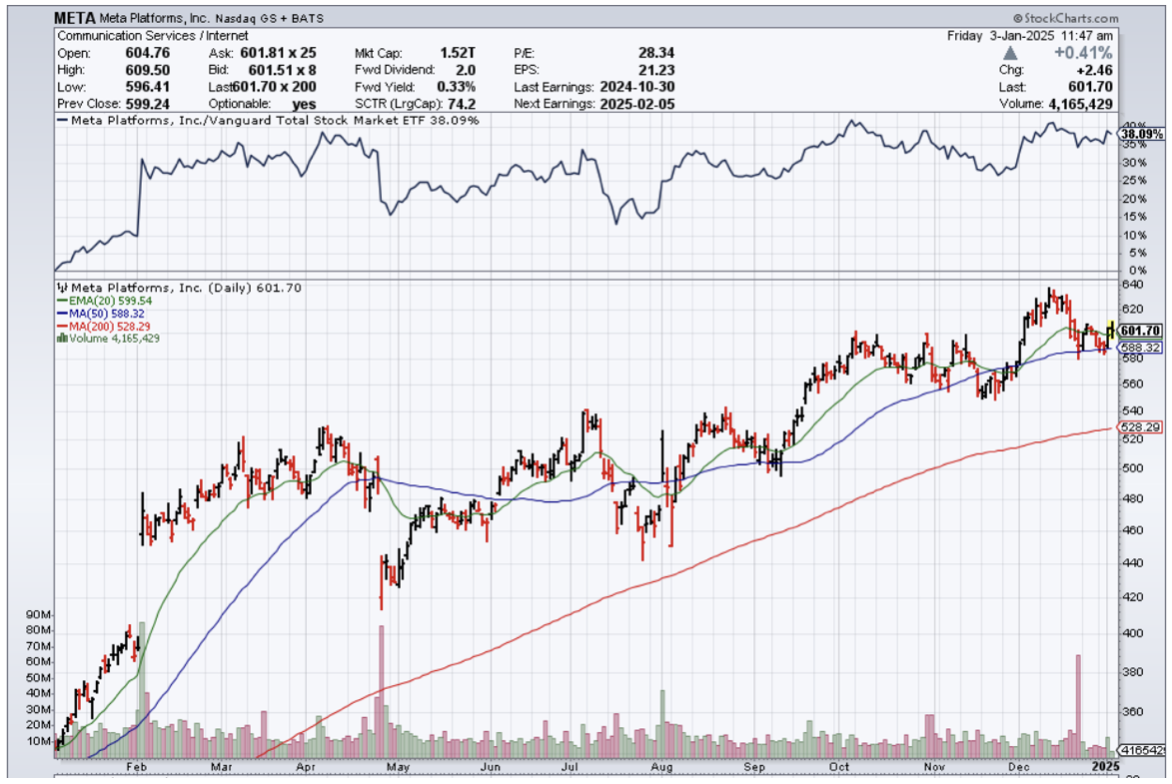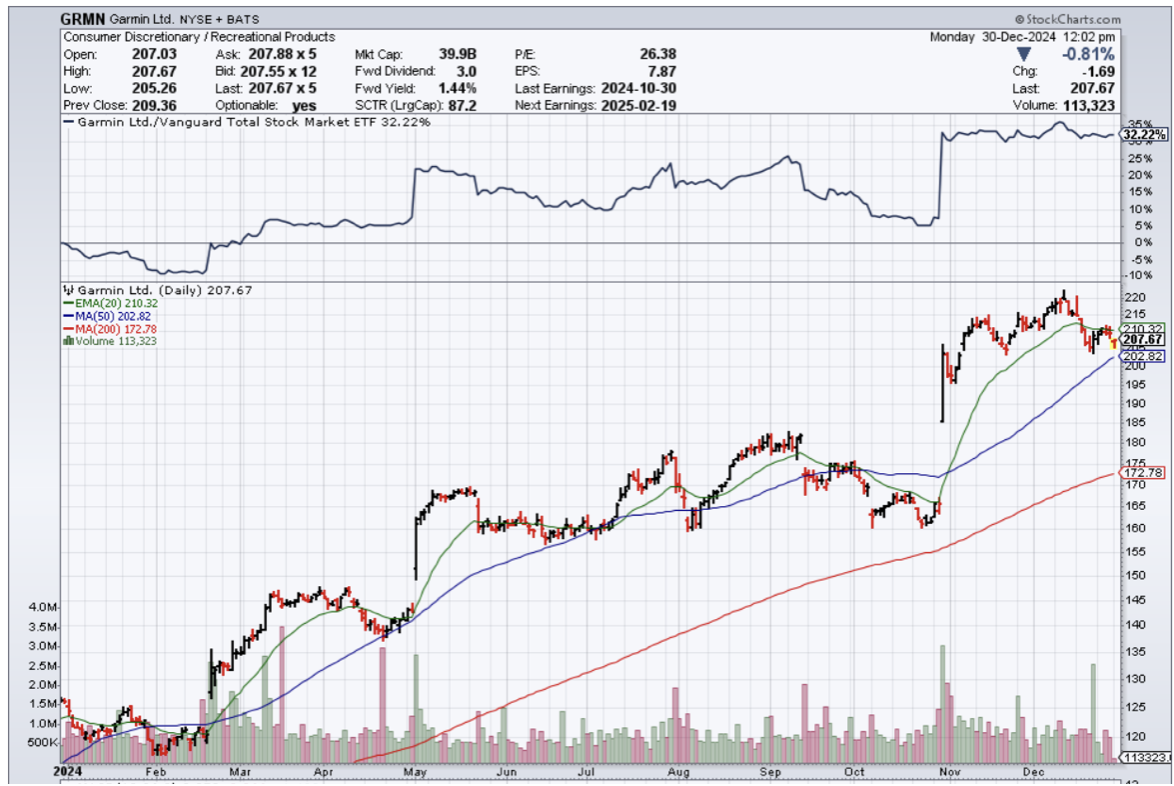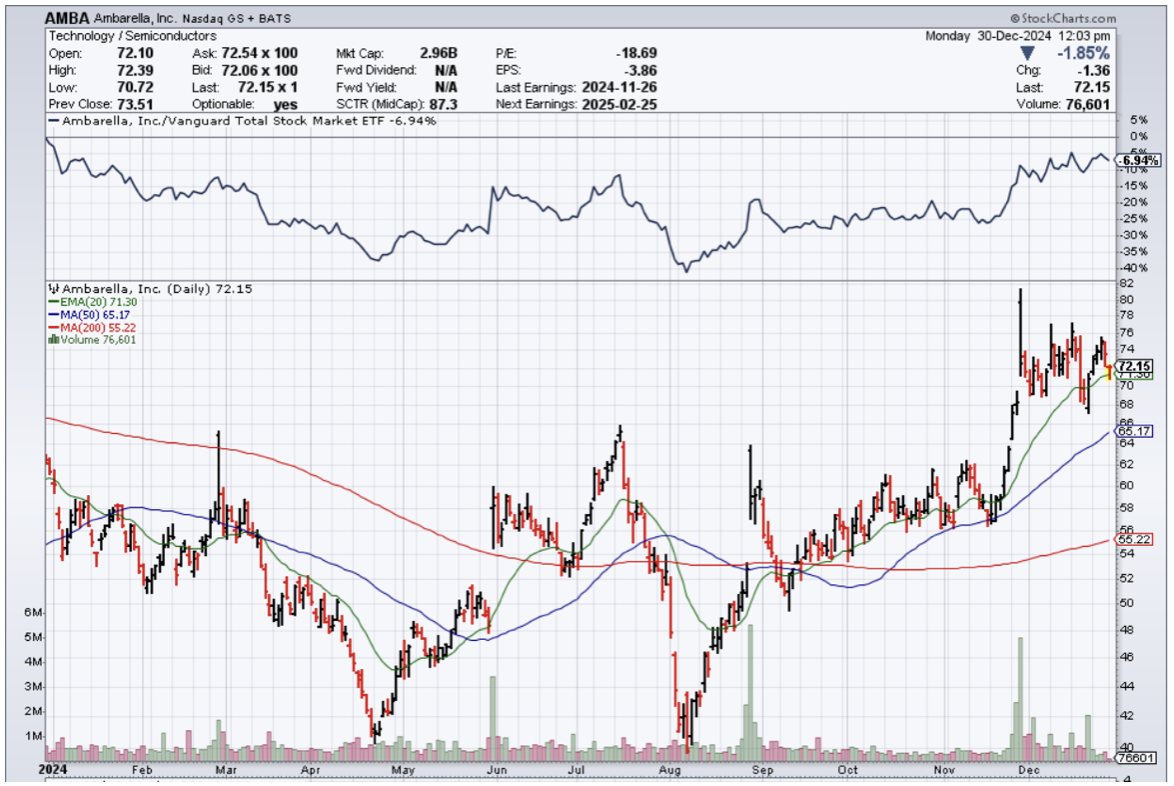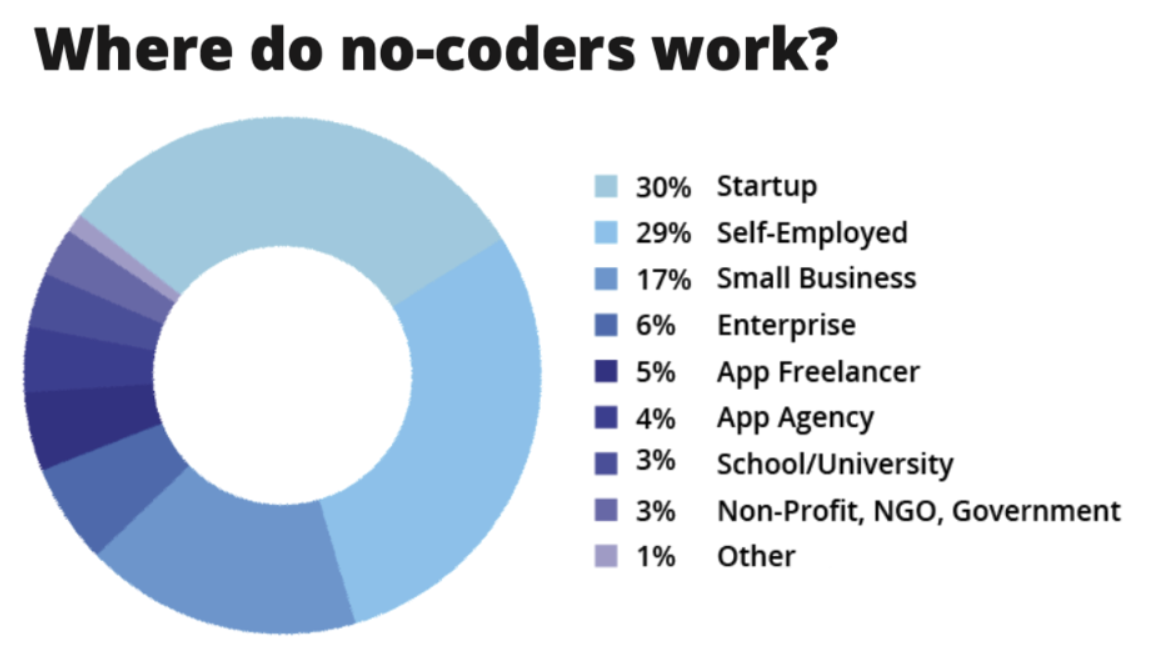Mad Hedge Technology Letter
January 3, 2025
Fiat Lux
Featured Trade:
(THE EYEWEAR PIVOT NOBODY SAW COMING)
(META), (ESSILORLUXOTTICA)

Mad Hedge Technology Letter
January 3, 2025
Fiat Lux
Featured Trade:
(THE EYEWEAR PIVOT NOBODY SAW COMING)
(META), (ESSILORLUXOTTICA)

Meta (META) migration into the eyewear business is a little bit of a head-scratcher until peeling back the layers and really understanding what is going on.
EssilorLuxottica’s agreement to prolong its long-term collaboration with Meta Platforms for the development of smart eyewear over the upcoming 10 years is a massive victory for Meta CEO Mark Zuckerberg.
This milestone offers meaningful insight into the direction of where the business model is heading.
Many have expected that Meta would start to branch out into other venues once their core businesses start to stagnate.
The digital ad game and social media platforms only go so far in terms of growth these days, and shareholders are waiting for the next big thing.
Short-term prospects are what drives the stock movement, and Meta is looking for that pixie dust.
EssilorLuxottica is the largest maker of eyewear in the world and the owner of many eyewear brands and retailers, including Ray-Ban, LensCrafters, and Pearle Vision in the U.S.
EssilorLuxottica also acquired Heidelberg Engineering, a maker of imaging and healthcare machinery and technology, largely for the ophthalmic and eyecare markets worldwide.
Prescription glasses are not cheap, ranging into the thousands of dollars for designer frames and lenses.
If Meta can figure out how to do this all online without going to the optician, imagine the juicy margins they could extract from this sort of venture.
Meta and EssilorLuxottica have a relationship for the production of the Ray-Ban smart glasses. The glasses’ latest version gives consumer’s video, camera, and Bluetooth headset capability in a stylish eyewear frame with a cool brand on it.
Heidelberg Engineering makes complex, sophisticated, expensive equipment that you may be exposed to if you’re examined in an ophthalmologist’s office. Buying Heidelberg makes EssilorLuxottica more entrenched in the industry where it is the established leader.
The tie-up with EssilorLuxottica is the perfect onboarding situation to understand how to perfect the optimal glasses and lenses and then transfer it into an online experience.
Remember, even if this investment is for VR purposes, the application revolves around virtual eyewear as well.
Meta now understands they need to secure a monopoly on eyewear, and it is a conscious decision to make that a launching point for more of their products.
In the future, Meta wants consumers to access Instagram, Whatsapp, and Facebook through EssilorLuxottica eyewear products.
Meta also hopes to secure the first mover advantage while other big tech firms lack the deep knowledge of eyewear. There have already been numerous failed attempts at smart glasses, and so Meta founder Mark Zuckerberg is doubling down with a relationship with Europe’s most deeply entrenched premium eyewear firm.
Although the boost to the bottom and top line won’t happen quickly with a possible relationship with EssilorLuxottica, this could anoint Meta as the gatekeeper to the new virtual world through this new eyewear tech.
It’s becoming clear that Meta is running up to certain upper limits in regards to the growth of their 3 platforms, and they are looking for another super booster to prop up profits.
I don’t believe that Meta will be allowed to acquire this eyewear company because of anti-competitive laws, but adopting its best product practices and hiring their best talent seems a lot more on brand from Meta.
Meta has never been shy at poaching outside talent and rewarding them handsomely.
On the flip side, EssilorLuxottica would be smart to adopt some tech now by hiring the right people and trying to digitize the experience further otherwise, Meta will get what they are coming for.
Meta pushing the envelope is one of the big reasons why they have stayed ahead of other big tech companies and why the stock has done so well the past few years.
Meta stock is a great short-term and long-term proposition for patient and impatient investors.

Mad Hedge Technology Letter
December 30, 2024
Fiat Lux
Featured Trade:
(THE UNBEATABLE PARTNERSHIP)
(EMR), (GRMN), (AMBA), (NVDA), (DXCM), (CSCO), (INTC), (QCOM)

Let me introduce to you one of the hottest trends in tech.
It has been on the tip of everyone's tongue for years, and that might be an understatement, but the interaction of the Internet of Things (IoT) and artificial intelligence (AI) offers companies a wide range of advantages.
In order to get the most out of IoT systems and to be able to interpret data, the symbiosis with AI is almost a must.
If the Internet of Things is merged with data analysis based on artificial intelligence, this is referred to as AIoT.
Moving forward, expect this to be the hot new phrase in an industry backdrop where investors love these hot catchphrases and monikers.
What is this used for?
Lower operating costs, shorter response times through automated processes, and helpful insights for business development are just a few of the notable advantages of the Internet of Things.
AI also offers a variety of business benefits: it reduces errors, automates tasks, and supports relevant business decisions. Machine learning as a sub-area of AI also ensures that models – such as neural networks – are adapted to data. Based on the models, predictions and decisions can be made. For example, if sensors deliver new data, they can be integrated into the existing modules.
The Statista Research Institute assumes that there will be 200 billion networked devices by 2026.
This is exactly where AI comes into play, which generates predictions based on the sensor values received.
However, many companies are still unable to properly benefit from the potential of connecting IoT and AI, or AIoT for short.
They are often skeptical about outsourcing their data - especially in terms of security and communication.
In part because the increased number of networked devices, which requires the connection of IoT and AI, increases the security requirements for infrastructure and communication structure enormously.
It is not surprising that companies are unsettled: Industrial infrastructures have grown historically due to constantly increasing requirements and present companies with completely new challenges, which manifest themselves, for example, in an increasing number of networked devices. With the combination of IoT and AI, many companies are venturing into relatively new territory.
By connecting IoT and AI, a continuous cycle of data collection and analysis is developing.
But, companies can no longer deny the advantages of AIoT because this technical combination makes networked devices and objects even more useful.
Based on the insights generated by the models, those responsible can make decisions more easily and reliably predict future events. In this way, a continuous cycle of data collection and analysis develops. With predictive maintenance, for example, production companies can forecast device failures and thus prevent them.
The combination of the two technologies also makes sense from the safety point of view: continuous monitoring and pattern recognition help to identify failure probabilities and possible malfunctions at an early stage – potential gateways can thus be better identified and closed in good time.
The result: companies optimize their processes, avoid costly machine failures, and at the same time reduce maintenance costs and thus increase their operational efficiency.
In this way, IoT and AI represent a profitable fusion: While AI increases the benefit of existing IoT solutions, AI needs IoT data in order to be able to draw any conclusions at all.
AIoT is, therefore, a real gain for companies of all sizes. They thus optimize processes, are less prone to errors, improve their products, and thus ensure their competitiveness in the long term.
Some hardware, software, and semiconductor stocks that will offer exposure into AIoT are Emerson Electric Co. (EMR), Garmin (GRMN), Ambarella (AMBA), Nvidia (NVDA), DexCom (DXCM), Cisco (CSCO), Intel (INTC), and Qualcomm (QCOM).



Mad Hedge Technology Letter
December 27, 2024
Fiat Lux
Featured Trade:
(THE TRUTH ABOUT AUTOMATION AND BANKING)
(SQ), (PYPL), (APPL), (AMZN)

Automation is taking place at warp speed, displacing employees from all walks of life.
According to a recent report, the U.S. financial industry will depose of 400,000 workers in the next decade because of automating efficiencies.
Yes, humans are going the way of the dodo bird, and banking will effectively become algorithms working for a handful of executives and engineers.
The x-factor in this equation is the $150 billion annually that banks spend on technological development in-house, which is higher than any other industry.
Welcome to the world of lower costs, shedding wage bills, and boosting performance rates.
We forget to realize that employee compensation eats up 50% of bank expenses.
The 400,000 job trimmings would result in 20% of the U.S. banking sector getting axed.
The hyped-up “golden age of banking” should deliver extraordinary savings and premium services to the customer at no extra cost.
This iteration of mobile and online banking has delivered functionality that no generation of customers has ever seen.
The most gutted part of banking jobs will naturally occur in the call centers because they are the low-hanging fruit for automated chatbots.
A few years ago, chatbots were suboptimal, even spewing out arbitrary profanity, but they have slowly crawled up in performance metrics to the point where some customers are unaware that they are communicating with an artificial engineered algorithm.
The wholesale integration of automating the back-office staff isn’t the end of it, the front office will experience a 30% drop in numbers, sullying the predated ideology that front-office staff are irreplaceable heavy hitters.
Front-office staff has already felt the brunt of downsizing, with purges carried out from 2022 representing a twelfth year of continuous decline.
Front-office traders and brokers are being replaced by software engineers as banks follow the wider trend of every company transitioning into a tech company.
The infusion of artificial intelligence will lower mortgage processing costs by 30%, and the accumulation of hordes of data will advance the marketing effort into a smart, multi-pronged, hybrid cloud-based, and hyper-targeted strategy.
The last two human bank hiring waves are a distant memory.
The most recent spike came in the 7 years after the dot com crash of 2001 until the sub-prime crisis of 2008, adding around half a million jobs on top of the 1.5 million that existed then.
After the subsidies wear off from the pandemic, I do believe that the banking sector will quietly put in the call to trim even more.
The longest and most dramatic rise in human bankers was from 1935 to 1985, a 50-year boom that delivered over 1.2 million bankers to the U.S. workforce.
This type of human hiring will likely never be seen again in the U.S. financial industry.
Recomposing banks through automation is crucial to surviving as fintech companies like PayPal (PYPL) and Square (SQ) are chomping at the bit, and even tech companies like Amazon (AMZN) and Apple (AAPL) have started tinkering with new financial products.
And if you thought that this phenomenon was limited to the U.S., think again, Europe is by far the biggest culprit by already laying off 102,000 employees in 2021, more than 10x higher the number of U.S. financial job losses, and that has continued in 2022, 2023 and 2024.
In a sign of the times, the European outlook has turned demonstrably negative, with Deutsche Bank announcing layoffs of 40,000 employees as it scales down its investment banking business.
Don’t tell your kid to get into banking because they will most likely be feeding on scraps at that point.

THE LAST STAGE OF HUMAN-FACING BANK SERVICES IS NOW!
Mad Hedge Technology Letter
December 23, 2024
Fiat Lux
Featured Trade:
(THE FUTURE IS HERE)
(NO CODE)

The future is here.
No code or low code will bring a raft of new innovative tech companies to market, and we are in the early innings of this transformative development.
What is no code?
No-code is an approach to designing and using applications that requires zero coding or knowledge of programming languages.
This type of software hits us at a perfect time when the home office is beginning to become ubiquitous.
The self-service movement that empowers business users will support the creation, manipulation, and employment of data-driven applications.
If we turn back the pages of history, companies need an army of software programmers to develop even the measliest application.
That was then, and this is now.
Fast forward to today, and automated technology doesn’t only include cutting-edge industries like automotive cars, but also software on laptops that can be rejigged by individual entrepreneurs.
That’s right, one person with no coding experience will be able to design, develop, and offer a real-life application with meaningful business value without the help of expert programmers.
The research data backs up my thesis with research firms projecting a 23% increase for the global market for this type of technology.
During the pandemic, low-code/no-code tools saw steady growth due to their effectiveness in addressing some of tech’s most complicated challenges.
The essential need to digitize workflows to enhance customer and employee experiences will be a boost to the efficiency of commercial and operational teams.
No-code platforms have evolved from just facilitating mundane tasks to making it possible for a broader range of business employees to truly own their automation and build new software applications with no coding while increasing organizational capacity.
A few risks that larger companies might consider is that even for remote developers building new applications, governance is paramount.
IT staff will need to install guardrails in place and have those built into low-code/no-code platforms to maintain consistent levels of security across the organization.
Cybersecurity solutions need to be integrated into this workflow by training every employee at the organization on security behavior and using compartmentalization and limited access to prevent opportunities for mistakes.
Hard landings are hard to recover from, and some can be crippling to the business model.
For no-code companies, harmonizing workflows is a key requirement for success.
In a low-code/no-code organization, departments should be able to work without silos and communicate freely across functions.
Elevated performance enabled by low-code/no-code tools will mean that the number of useful apps hurling towards the marketplace will be more and merrier than ever before.
Higher performance will no doubt usher in a new renaissance of efficiency and even better performance.
This also puts a 3 or even 4-day workweek squarely in play.
Many of the best tech minds in the world have supported the concept of working smarter instead of working harder.
A low code/no-code standard will allow for these achievements to take place.
The cratering of costs to start and run a tech firm is affected, too.
Deploying startup capital to pay for other expenses will make it easier for successful incubation.
This will ultimately mean that this new type of tech company will need to embrace the fusion of IT and business staff, empowering them with composable applications to speed up the time to market for new solutions.
Low-code/no-code APIs and other tools are enabling companies to integrate new applications into their existing tech stack in a more seamless manner with a lift-and-shift approach vs a rip-and-replace.
At the entrepreneur level, individuals will be able to harness the technology to build $100 million companies with a snap of the fingers when it wasn’t possible to do it before.
This is finally a chance for the little guy to recapture their moxie in the vast and sometimes overwhelming business world.

“If you're not stubborn, you'll give up on experiments too soon.” – Said Founder of Amazon Jeff Bezos

Legal Disclaimer
There is a very high degree of risk involved in trading. Past results are not indicative of future returns. MadHedgeFundTrader.com and all individuals affiliated with this site assume no responsibilities for your trading and investment results. The indicators, strategies, columns, articles and all other features are for educational purposes only and should not be construed as investment advice. Information for futures trading observations are obtained from sources believed to be reliable, but we do not warrant its completeness or accuracy, or warrant any results from the use of the information. Your use of the trading observations is entirely at your own risk and it is your sole responsibility to evaluate the accuracy, completeness and usefulness of the information. You must assess the risk of any trade with your broker and make your own independent decisions regarding any securities mentioned herein. Affiliates of MadHedgeFundTrader.com may have a position or effect transactions in the securities described herein (or options thereon) and/or otherwise employ trading strategies that may be consistent or inconsistent with the provided strategies.
This site uses cookies. By continuing to browse the site, you are agreeing to our use of cookies.
OKLearn moreWe may request cookies to be set on your device. We use cookies to let us know when you visit our websites, how you interact with us, to enrich your user experience, and to customize your relationship with our website.
Click on the different category headings to find out more. You can also change some of your preferences. Note that blocking some types of cookies may impact your experience on our websites and the services we are able to offer.
These cookies are strictly necessary to provide you with services available through our website and to use some of its features.
Because these cookies are strictly necessary to deliver the website, refuseing them will have impact how our site functions. You always can block or delete cookies by changing your browser settings and force blocking all cookies on this website. But this will always prompt you to accept/refuse cookies when revisiting our site.
We fully respect if you want to refuse cookies but to avoid asking you again and again kindly allow us to store a cookie for that. You are free to opt out any time or opt in for other cookies to get a better experience. If you refuse cookies we will remove all set cookies in our domain.
We provide you with a list of stored cookies on your computer in our domain so you can check what we stored. Due to security reasons we are not able to show or modify cookies from other domains. You can check these in your browser security settings.
These cookies collect information that is used either in aggregate form to help us understand how our website is being used or how effective our marketing campaigns are, or to help us customize our website and application for you in order to enhance your experience.
If you do not want that we track your visist to our site you can disable tracking in your browser here:
We also use different external services like Google Webfonts, Google Maps, and external Video providers. Since these providers may collect personal data like your IP address we allow you to block them here. Please be aware that this might heavily reduce the functionality and appearance of our site. Changes will take effect once you reload the page.
Google Webfont Settings:
Google Map Settings:
Vimeo and Youtube video embeds:
